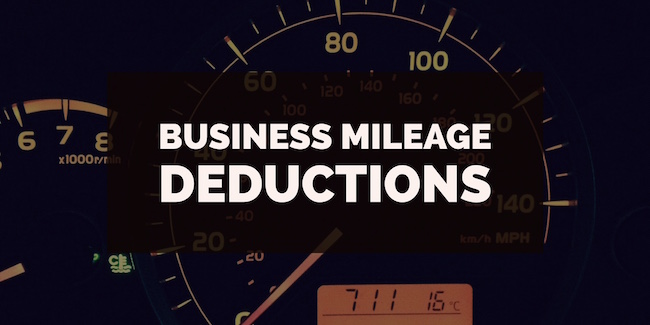Whether you’re a freelancer or small business owner, growing revenue and maintaining cash flow should be two of your top priorities. That’s why it’s necessary for you to find clever ways to keep the cash flowing-in. One of the most overlooked ways to bring-in some extra cash is through tax deductions, specifically business mileage deductions for your vehicle.
“Our average user is returning $6,500 in deductions or reimbursements each year,” says MileIQ CEO Chuck Dietrich. “People don’t realize how quickly the dollars add up. A 10-mile drive is worth $5.40 [for 2016 taxes].”
While business mileage deductions won’t make you a millionaire overnight, it’s an easy way to generate thousands of dollars each-year. So, with that in mind, here’s how you can make the most of you business mileage deductions.
Table of Contents
ToggleWhat qualifies as a mileage deduction?
If you drive your car or vehicle for business purposes then you can take the standard mileage deduction of 54 cents for every mile that you drive. This includes;
- Travel between offices.
- Running business-related errands like going to the bank or picking-up supplies.
- Driving to meet clients for coffee, lunch, or dinner.
- Going to and from the airport or driving for a business trip.
- Traveling to odd or side-gigs.
- Visiting clients or customers.
- Driving from home to a temporary job site.
- Searching for employment.
But, that’s not all. You can also deduct certain moving expenses, gas and oil expenses, parking, tolls, and car-washing. For visiting the doctor there’s a deductible expense at 19 cents per mile, And, if you volunteer you’ll be able to deduct 14 cents per mile.
Keep in mind though though commuting is not business mileage. As Jean Murray explains in an article for The Balance, “The time you spend driving back and forth between your home and your business is considered commuting, and the expenses associated with commuting (standard mileage or actual expenses) are not deductible as a business expense.”
“You cannot deduct commuting expense no matter how far your home is from your place of work. Consider it this way – everyone needs to get to work, employees and business owners alike, so this expense is not part of your business.”
There two main exceptions, however. The first is if your home office is your principal place of business. This means that traveling from your to other work locations can be deducted. The other exception are the expenses it costs you to go from your home and a temporary work site that is outside of the area where you normally work.
To be on the safe side, discuss these business deductions with your tax advisor prior to filing them with the IRS.
Standard mileage vs. actual expenses.
You have two options when it comes to deducting your vehicle expenses; the standard mileage method or the actual expenses method.
The standard mileage method is the easiest to calculate. You simply multiply your business miles with the current mileage rate, which is 54 cents in 2016.
If you’re a salesman or Uber driver and drove 15,000 miles, then your total mileage deduction for the year would be $8,100.
With the actual expense method you would total all of your costs of operating the vehicle and then multiply them by the percentage of business use. These expenses include lease payments, auto loan interest, insurance, maintenance and repairs, depreciation, and registration.
If this totaled $7,500 and you used your vehicle for business purposes 50 percent of the time then your deduction would be $3,750.
Meticulously maintain mileage records.
To avoid any audits, penalties, or fines from the IRS it’s your responsibility to keep accurate and detailed records that support your vehicle expense claims. You can do this by manually entering this information into a logbook or spreadsheet. And, don’t forget to keep those receipts.
But, you can also automate the process through apps like MileIQ, TripLog, and TrackMyDrive. They’re available for both Android and iOS devices and can easily and accurately record each mile you drive by using GPS tracking.
Itemize your deductions.
“If you’re not itemizing, it doesn’t matter if you drove 8,000 miles. Sorry,” says Nicole Odeh, founder and president of The Small Business Accounting Solutions.
You can classify your deductions in the following categories medical, charitable, business, moving, and personal.
The reason that you want to itemize your deductions is it not only keeps your records organized, it maximizes your tax savings since it allows you to claim a larger deduction. Thankfully, when you use the app listed above you can classify the trip as business, personal, medical, charity or ar custom category of your preference.
Work from home or self-employed? No problem.
As mentioned earlier, if you work from home, then there’s a loophole in the commuting rule. That’s because since you’re already “at work” any work-related trips that you have to make will count as a mileage deduction.
In fact, the self-employed enjoy the highest deduction rate and fewest restrictions when it comes to business mileage deductions.
Final words of advice.
Unless your vehicle is 100% for business-use only, don’t try to be cute and claim 100% of your trips as business miles. You’re still using that vehicle for personal use, like grocery shopping or visiting your friends in another state. You’re just asking for an audit if you go this route.
Also, don’t round your business mileage. No one has a clean, round number when it comes to miles. Again, this is another red flag that the IRS is looking for.
Finally, don’t use the same miles from previous years. It’s just not possible that you have been driving 15,367 miles for three consecutive years.















